ABS PONTIAC GRAND-PRIX 1993 Owners Manual
[x] Cancel search | Manufacturer: PONTIAC, Model Year: 1993, Model line: GRAND-PRIX, Model: PONTIAC GRAND-PRIX 1993Pages: 338, PDF Size: 17.3 MB
Page 4 of 338
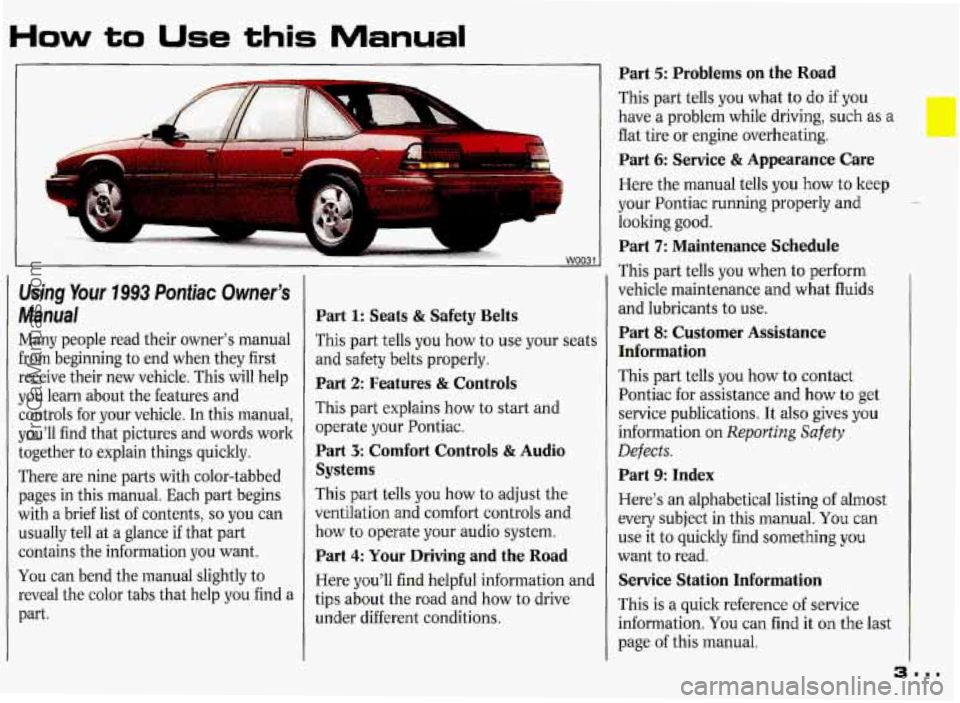
How to Use this Manual
b
Using Your 1993 Pontiac Owner’s
Manual
Many people read their owner’s manual
from beginning to end when they first
receive their new vehicle. This will help
you learn about the features and
controls for your vehicle. In this manual,
you’ll find that pictures and words work
together to explain things quicltly.
There are nine parts with color-tabbed pages in this manual. Each part begins
with a brief list of contents,
so you can
usually tell at a glance if that part
contains the information you want.
You can bend the manual slightly to
reveal the color tabs that help you find a
part.
Part 1: Seats & Safety Belts
This part tells you how to use your seat:
and safety belts properly.
Part 2: Features 8z Controls
This part explains how to start and
operate your Pontiac.
Part 3: Comfort Controls & Audio
Systems
This part tells you how to adjust the
ventilation
and comfort controls and
how to operate your audio system.
Part 4: Your Driving and the Road
Here you’ll find helpful information anc
tips about the road and how to drive
under different conditions.
Part 5: Problems on the Road
This part tells you what to do if you
have a problem while driving, such as a
flat tire or engine overheating.
Part 6: Service & Appearance Care
Here the manual tells you how to keep
your Pontiac running properly and
looking good.
Part 7: Maintenance Schedule
This part tells you when to perform
vehicle maintenance and what fluids
and lubricants to use.
Part 8: Customer Assistance
Information
This part tells you how to contact
Pontiac for assistance and how
to get
service publications. It also gives you
information on
Reporting Safety
Defects.
Part 9: Index
Here’s an alphabetical listing of almost
every subject in this manual.
You can
use it to quicltly find something
you
want to read.
Service Station Information
This is a quick reference of service
information.
You can find it on the last
page of this manual.
~~.
ProCarManuals.com
Page 148 of 338
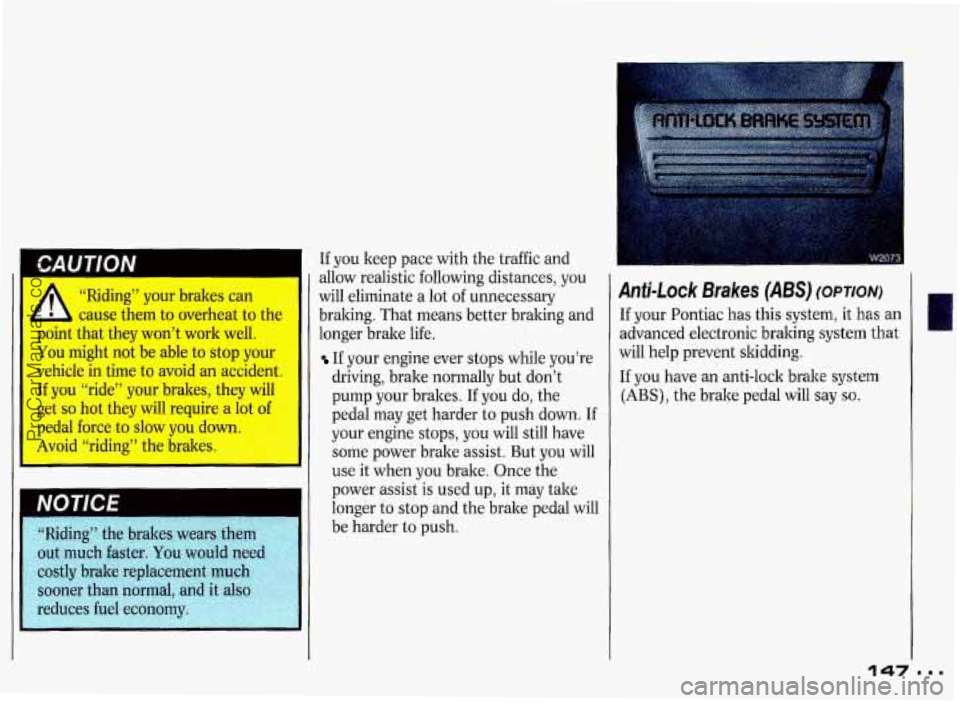
‘Riding” your brakes can
:ause them to overheat to t
point that they won’t work well.
You might not be able to stop your
vehicle in time to avoid an accident.
If you “ride” your brakes, they will
get
so hot they will require a lot of
pedal force to slow you
&--
Avoid “riding” the brake-. 3
I’
rs wears them 1 ”)- 2.’;
out much faster. You would need 253
costly brake replacement much 35
sooner than normal, and it also ?$:
.,,&
,,.7.. d:$
/P ,=;.;>,:
If you keep pace with the traffic and
allow realistic following distances, you
will eliminate a lot of unnecessary
braking. That means better braking and
longer brake life.
If your engine ever stops while you’re
driving, brake normally but don’t
pump your brakes. If you do, the
pedal may get harder to push down. If
your engine stops, you will still have
some power brake assist. But you will
use it when you brake. Once the
power assist is used up, it may take
longer to stop and the brake pedal will
be harder to push.
Anti-Lock Brakes (ABS) (OPTION)
If your Pontiac has this system, it has an
advanced electronic braking system
that
will help prevent skidding.
If you have an anti-lock brake system
(ABS), the brake pedal will say so.
ProCarManuals.com
Page 149 of 338
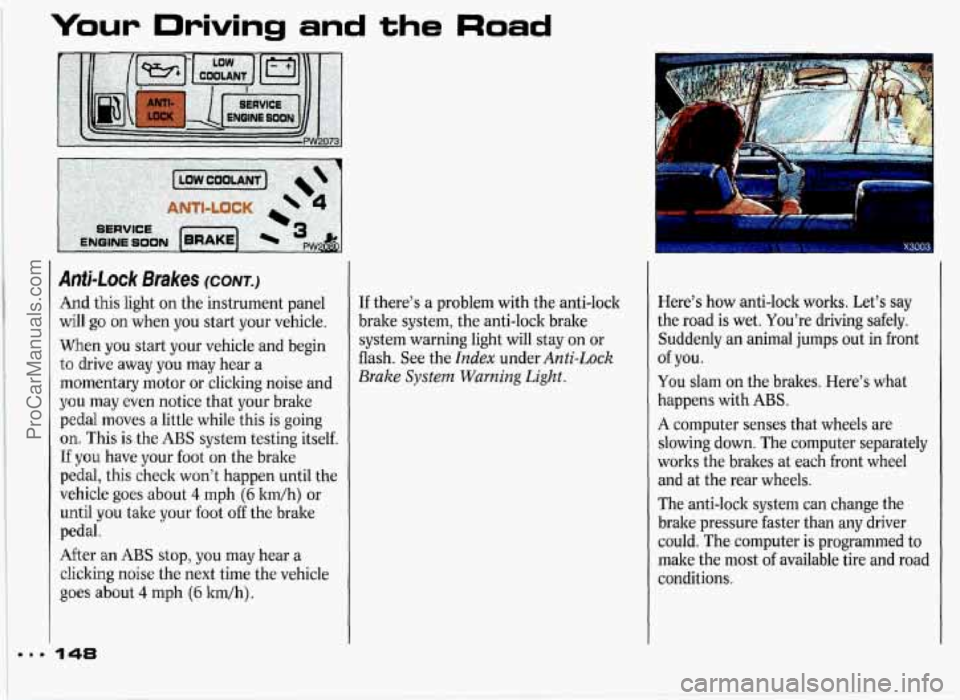
ma.
Your Driving and the Road
Anti-lock Brakes (CONT.)
And this light on the instrument panel
will
go on when you start your vehicle.
When you start your vehicle and begin
to drive away you may hear a
momentary motor or clicking noise and
you may even notice that your brake
pedal moves a little while this is going
on. This is the ABS system testing itself.
If you have your foot on the brake
pedal, this check won't happen until the
vehicle goes about
4 mph (6 ltm/h) or
until you take your foot off the brake
pedal.
After
an ABS stop, you may hear a
clicking noise the next time the vehicle
goes about 4 mph (6 ltdh).
148
If there's a problem with the anti-lock
brake system, the anti-lock brake
system warning light will stay on or
flash. See the
Index under Anti-Lock
Brake
System Warning Light.
Here's how anti-lock works. Let's say
the road is wet. You're driving safely.
Suddenly an animal jumps out in front
You slam on the brakes. Here's what
happens with
ABS.
A computer senses that wheels are
slowing down. The computer separately
works the brakes at each front wheel
and at the rear wheels.
The anti-lock system can change the
brake pressure faster than any driver
could. The computer is programmed to
make the most
of available tire and road
conditions.
of you.
ProCarManuals.com
Page 182 of 338
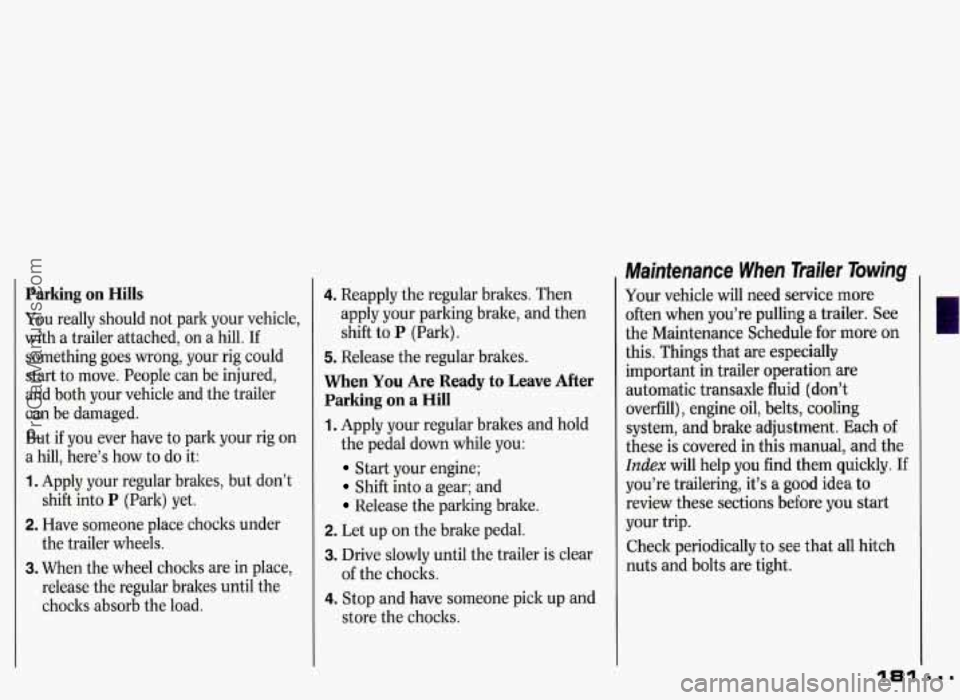
Parking on Hills
You really should not park your vehicle,
with a trailer attached, on a hill.
If
something goes wrong, your rig could
start to move. People can be injured,
and both your vehicle and the trailer
can be damaged.
But if you ever have to park your rig on
a hill, here’s how to do it:
1. Apply your regular brakes, but don’t
shift into
P (Park) yet.
2. Have someone place chocks under
the trailer wheels.
3. When the wheel chocks are in place,
release the regular brakes until the
chocks absorb the load.
4. Reapply the regular brakes. Then
apply your parking brake, and then
shift to
P (Park).
5. Release the regular brakes.
When You Are Ready to Leave After
Parking
on a Hill
1. Apply your regular brakes and hold
the pedal down while you:
Start your engine;
Shift into a gear; and
Release the parking brake.
2. Let up on the brake pedal.
3. Drive slowly until the trailer is clear
4. Stop and have someone pick up and
of
the chocks.
store the choclts.
Maintenance When Trailer Towing
Your vehicle will need service more
often when you’re pulling a trailer. See
the Maintenance Schedule for more on
this. Things that are especially
important in trailer operation
are
automatic transaxle fluid (don’t
overfill), engine oil, belts, cooling
system, and brake adjustment. Each
of
these is covered in this manual, and the
Index will help you find them quickly. If
you’re trailering, it’s a good idea to
review these sections before you start
your trip.
Check periodically to see that all hitch
nuts and bolts are tight.
IBI ...
ProCarManuals.com
Page 242 of 338
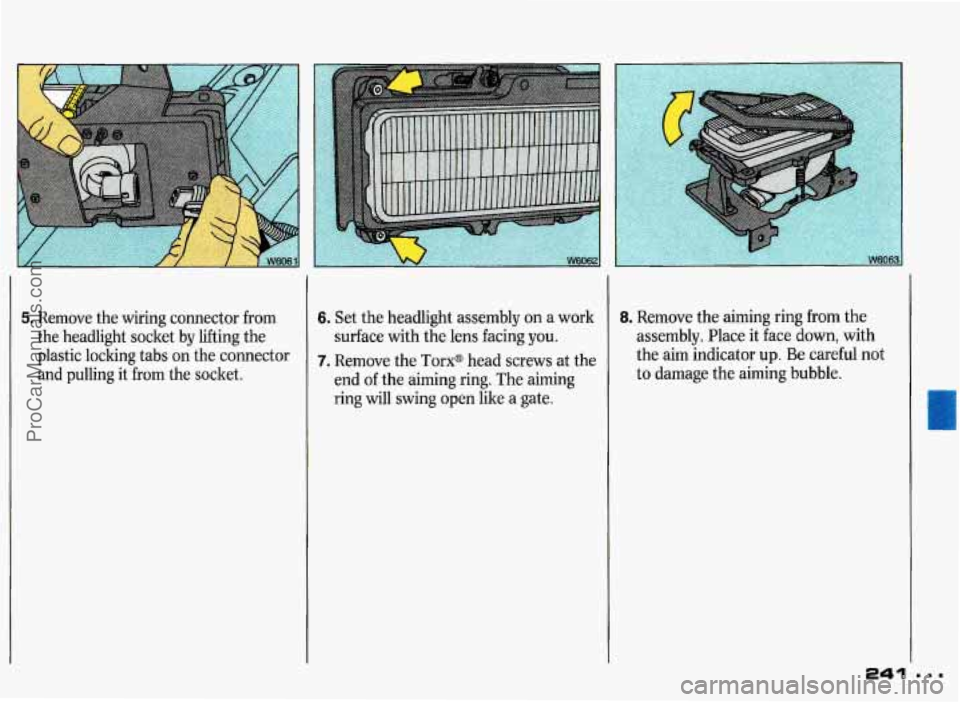
5. Remove the wiring connector from
the headlight socket by lifting the
plastic locking tabs on the connector
and pulling it from the socket. 6. Set the headlight assembly on a work
surface with the lens facing
you.
7. Remove the Torx@ head screws at the
end of the aiming ring. The aiming
ring
will swing open like a gate.
8. Remove the aiming ring from the
assembly. Place it face down, with
the aim indicator up.
Be careful not
to damage the aiming bubble.
241
L
e..
ProCarManuals.com
Page 243 of 338
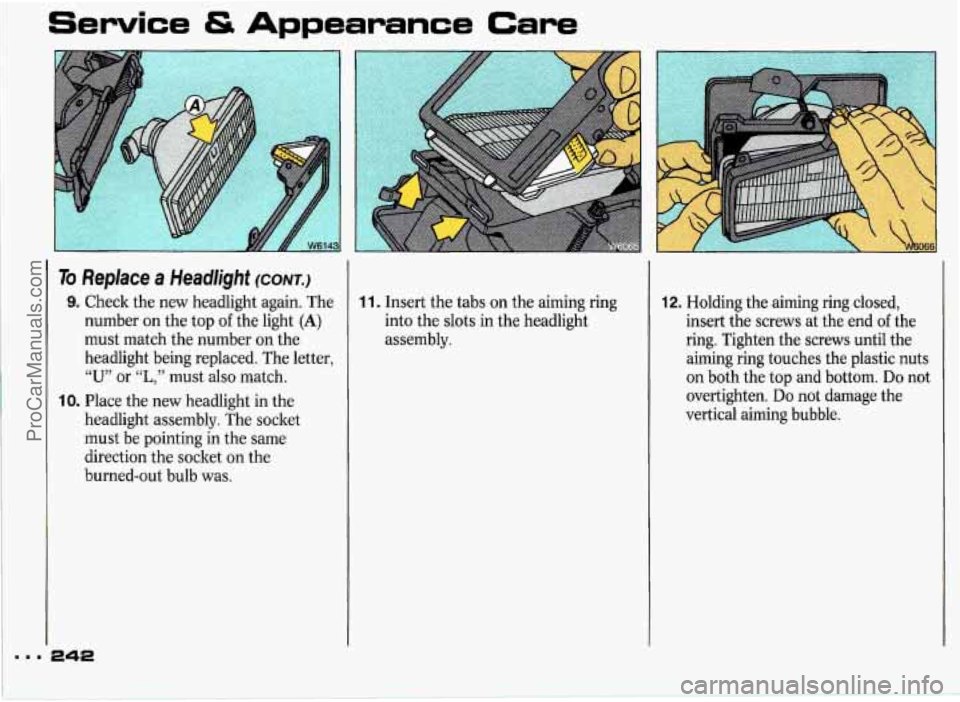
..I
Service & Appearance Care
To Replace a Headlight (CONT.)
9. Check the new headlight again. The
number on the top
of the light (A)
must match the number on the
headlight being replaced. The letter,
“U” or “L,” must also match.
10. Place the new headlight in the
headlight assembly. The socket
must be pointing in the same
direction the socket on the
burned-out bulb
was.
242
1 1. Insert the tabs on the aiming ring
into the slots in the headlight
assembly. 12. Holding the aiming ring closed,
insert the screws at the end
of the
ring. Tighten the screws until the
aiming ring touches the plastic nuts
on both the top and bottom.
Do not
overtighten.
Do not damage the
vertical aiming bubble.
ProCarManuals.com
Page 244 of 338
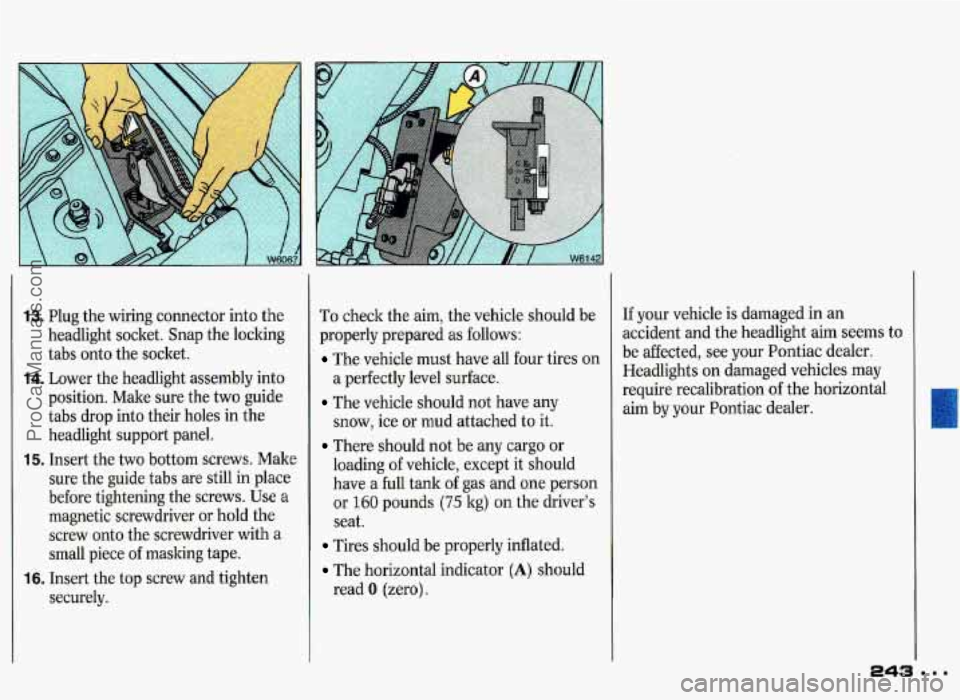
13. Plug the wiring connector into the
headlight socket. Snap the locking
tabs onto the socket.
14. Lower the headlight assembly into
position. Make sure the two guide
tabs
drop into their holes in the
headlight support panel.
15. Insert the two bottom screws. Make
sure the guide tabs are still in place
before tightening the screws. Use a
magnetic screwdriver or hold the
screw onto the screwdriver with a
small piece
of masking tape.
16. Insert the top screw and tighten
securely. To check
the aim, the vehicle should be
properly prepared as follows:
The vehicle must have all four tires on
a perfectly level surface.
The vehicle should not have any
snow, ice or mud attached to it.
There should not be any cargo or
loading of vehicle, except it should
have a full tank of gas and one person
or
160 pounds (75 kg) on the driver’s
seat.
Tires should be properly inflated.
The horizontal indicator (A) should
read
0 (zero). If
your vehicle
is damaged in an
accident and the headlight aim seems to
be affected, see your Pontiac dealer.
Headlights on damaged vehicles may
require recalibration of the horizontal
aim by your Pontiac dealer.
U
ProCarManuals.com
Page 250 of 338
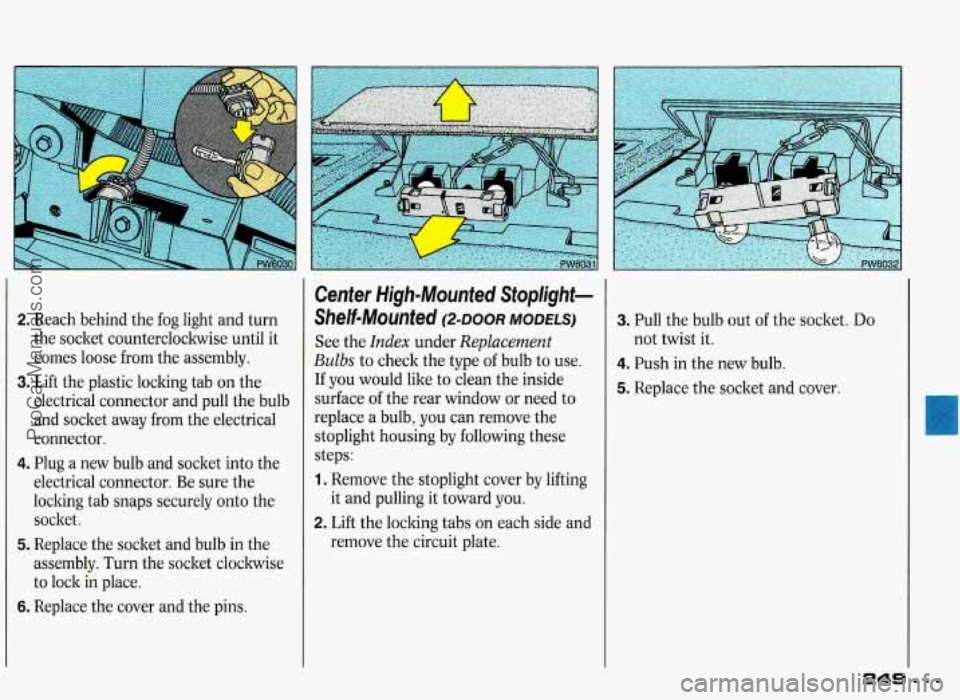
2. Reach behind the fog light and turn
the socket counterclockwise until it
comes loose from the assembly.
3. Lift the plastic locking tab on the
electrical connector and pull the bulb
and socket away
from the electrical
connector.
4. Plug a new bulb and socket into the
electrical connector. Be sure the
locking tab snaps securely onto the
socket.
5. Replace the socket and bulb in the
assembly.
Turn the socket clockwise
to lock in place.
6. Replace the cover and the pins.
Center High-Mounted Stoplight-
Shelf-Mounted DOOR MODELS)
See the Index under Replacement
Bulbs to check the type of bulb to use.
If you would like to clean the inside
surface
of the rear window or need to
replace a bulb, you can remove the
stoplight housing by following these
steps:
1. Remove the stoplight cover by lifting
2. Lift the locking tabs on each side and
it
and pulling it toward you.
remove the circuit plate.
3. Pull the bulb out of the socket. Do
4. Push in the new bulb.
5. Replace the socket and cover.
not
twist it.
249 =
ProCarManuals.com
Page 251 of 338
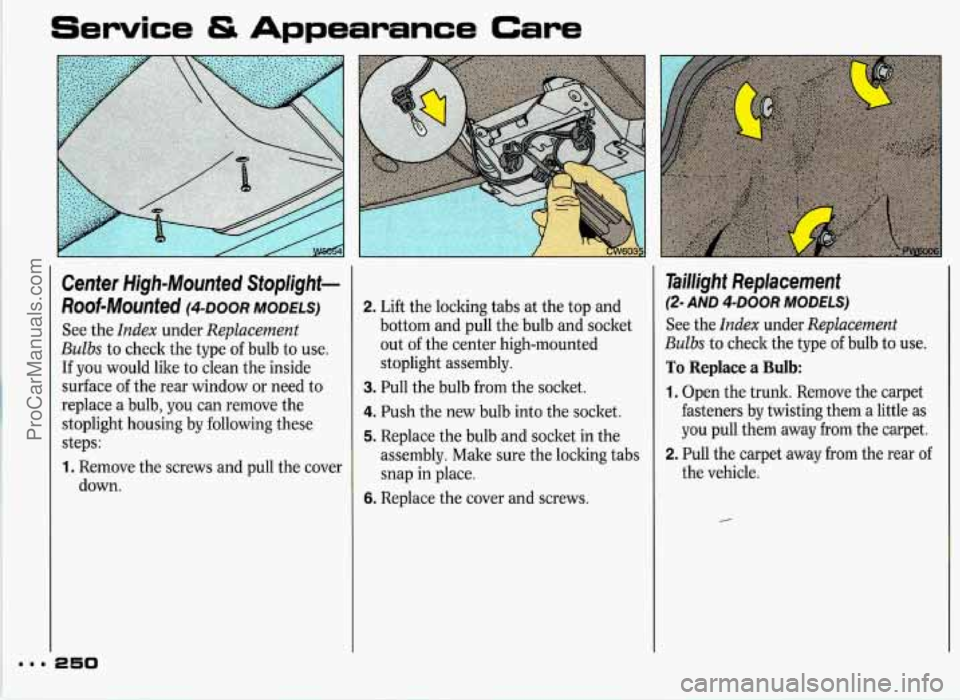
Service & Appearance Care
I
~
..I
Center High-Mounted Stoplight-
Roof-Mounted
DOOR MODELS)
See the Index under Replacement
Bulbs
to check the type of bulb to use.
If you would like to clean the inside
surface of the rear window or need to
replace a bulb, you can remove the
stoplight housing by following these
steps:
I. Remove the screws and pull the cover
down.
250
2. Lift the locking tabs at the top and
bottom and pull the bulb and socket
out of the center high-mounted
stoplight assembly.
3. Pull the bulb from the socket.
4. Push the new bulb into the socket.
5. Replace the bulb and socket in the
assembly. Make sure the locking tabs
snap in place.
6. Replace the cover and screws.
Taillight Replacement
(2- AND 4-DOOR MODELS)
See the Index under Replacement
Bulbs
to check the type of bulb to use.
To Replace a Bulb:
1. Open the trunk. Remove the carpet
fasteners by twisting them
a little as
you pull them away from the carpet.
2. Pull the carpet away from the rear of
the vehicle.
ProCarManuals.com
Page 272 of 338
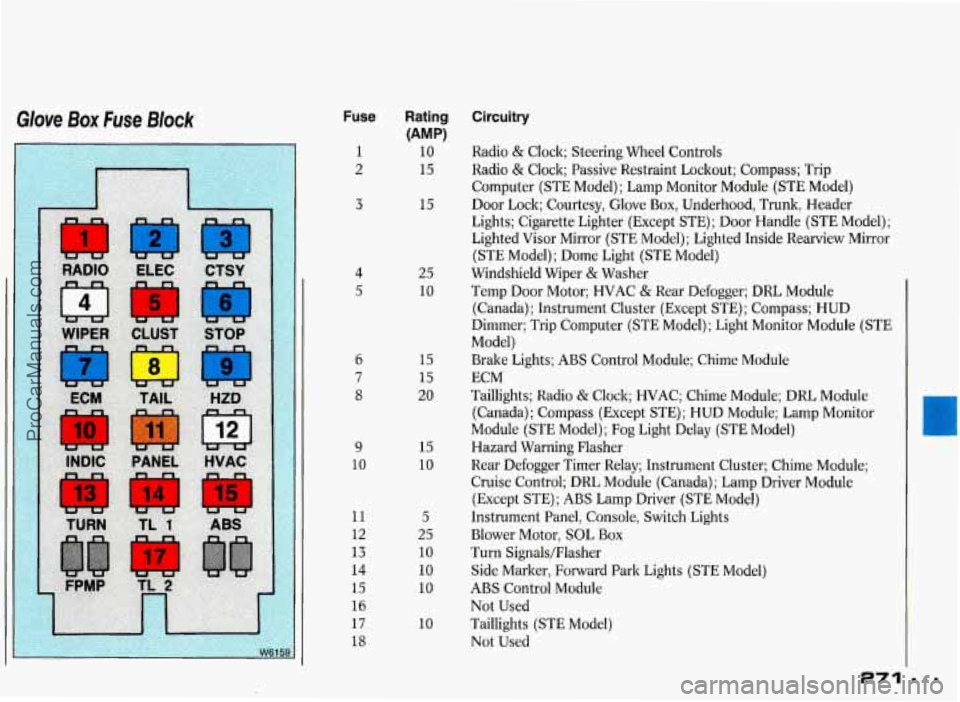
Glove Box Fuse Block
3
1
2
3
4
5
6
7
S
9
10
11
12
13
14
15
16
17
1s
Fuse Rating Circuitry
(AMP)
10 Radio & Clock; Steering Wheel Controls
15 Radio & Clock; Passive Restraint Lockout; Compass; Trip
Computer (STE Model)
; Lamp Monitor Module (STE Model)
15 Door Lock; Courtesy, Glove Box, Underhood, Trunk, Header
Lights; Cigarette Lighter (Except STE); Door Handle (STE Model);
Lighted Visor Mirror (STE Model); Lighted Inside Rearview Mirror
(STE Model); Dome Light (STE Model)
25 Windshield Wiper & Washer
10 Temp Door Motor; HVAC
& Rear Defogger; DRL Module
(Canada); Instrument Cluster (Except STE); Compass; HUD
Dimmer; Trip Computer (STE Model); Light Monitor Module (STE
Model)
15 Brake Lights; ABS Control Module; Chime Module
15 ECM
20 Taillights; Radio
& Clock; HVAC; Chime Module; DRL Module
(Canada)
; Compass (Except STE) ; HUD Module; Lamp Monitor
Module (STE Model); Fog Light Delay (STE Model)
15 Hazard Warning Flasher
10 Rear Defogger Timer Relay; Instrument Cluster; Chime Module;
Cruise Control; DRL Module (Canada); Lamp Driver Module
(Except STE)
; ABS Lamp Driver (STE Model)
5 Instrument Panel, Console, Switch Lights
25 Blower Motor, SOL Box
10 Turn Signals/Flasher
10 Side Marker, Forward Park Lights (STE Model)
10 ABS Control Module
Not Used
Taillights (STE Model)
Not Used
10
ProCarManuals.com